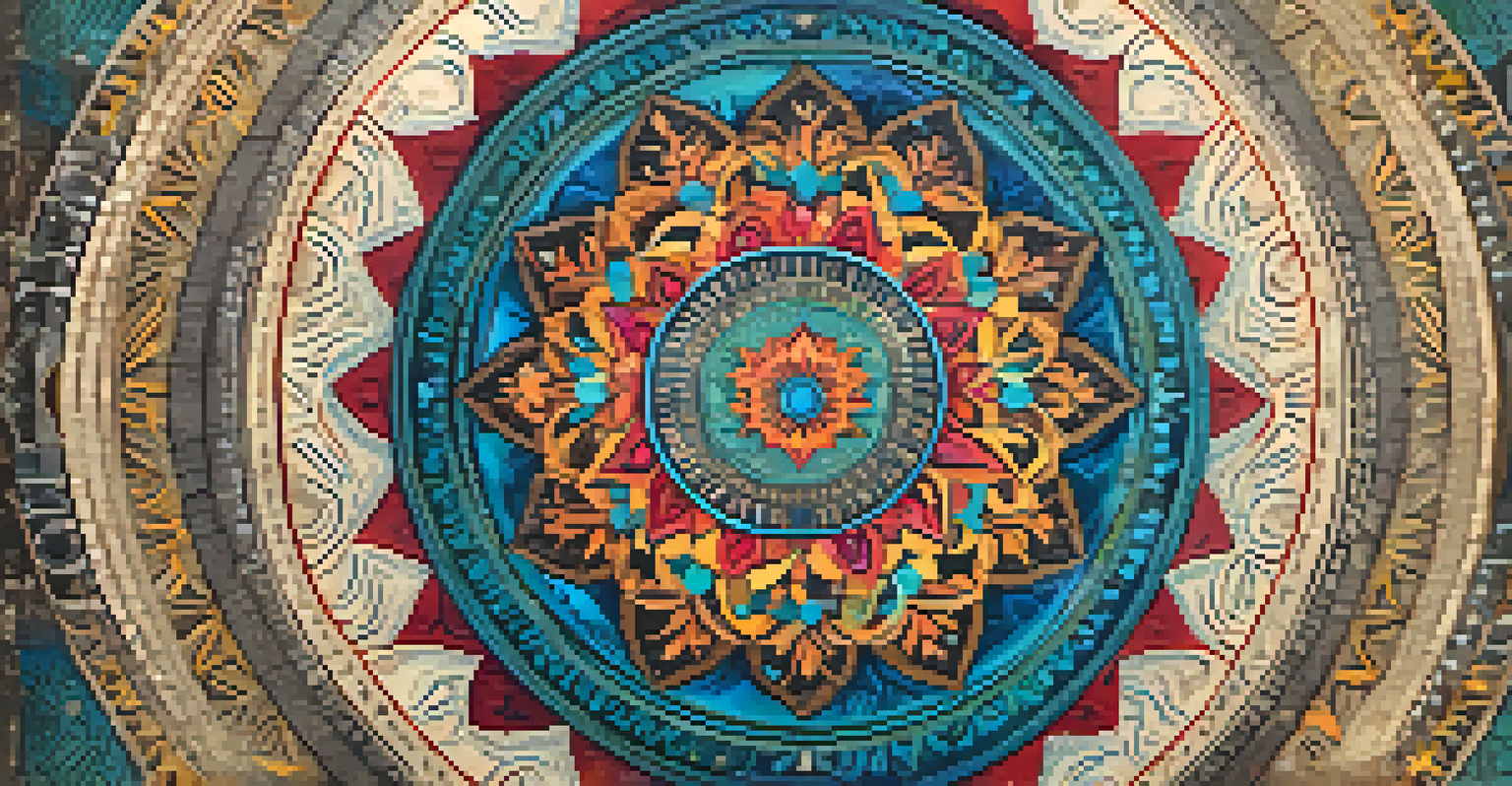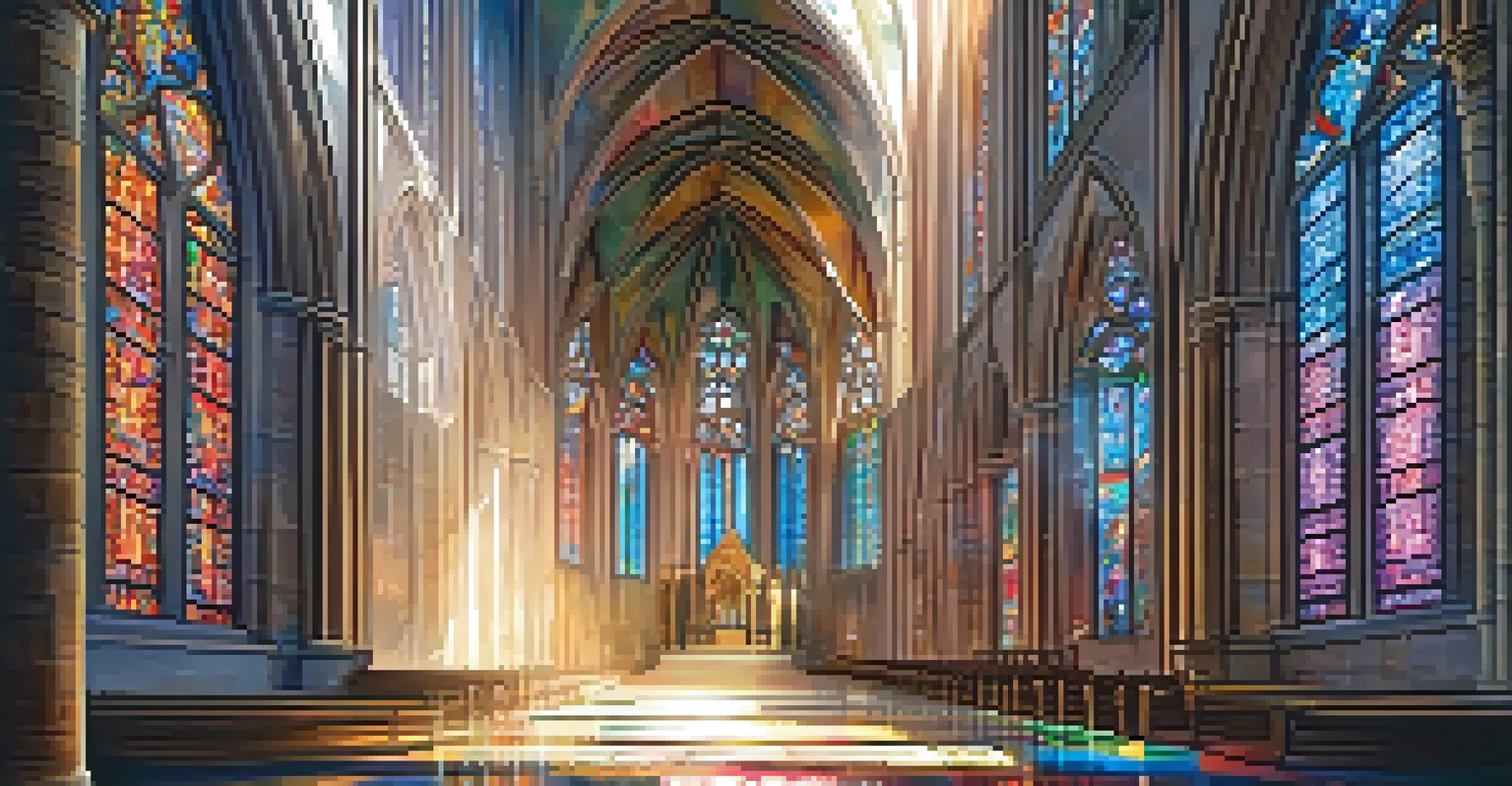Spiritual Symbols in Cultural Heritage: Meaning and Importance

Understanding Spiritual Symbols in Various Cultures
Spiritual symbols serve as powerful representations of beliefs, values, and traditions within cultures. They often embody the essence of a community's worldview, connecting individuals to their spiritual heritage. For example, the lotus flower in Hinduism symbolizes purity and enlightenment, reflecting the journey of the soul.
Symbols are the language of the spirit, and they are the key to understanding the mysteries of life.
These symbols can take various forms, including artwork, architecture, or everyday objects. Each form carries its own significance, often rooted in the historical and spiritual narratives of a culture. By exploring these symbols, we gain insight into the shared experiences and values that shape diverse societies.
Understanding spiritual symbols helps us appreciate the richness of cultural heritage. It allows us to recognize common threads that unite different peoples, fostering respect and empathy across cultural boundaries.
The Role of Spiritual Symbols in Cultural Identity
Cultural identity is deeply intertwined with spiritual symbols, as they often serve as markers of belonging. For instance, the cross in Christianity or the crescent moon in Islam not only signify faith but also create a sense of community among followers. These symbols instill pride and continuity in traditions passed down through generations.

Moreover, spiritual symbols can act as a source of resilience. In times of hardship, communities often look to these symbols for strength and hope, reinforcing their identity and purpose. This connection to spiritual representation can be a guiding light in navigating the complexities of modern life.
Spiritual Symbols Unite Cultures
Spiritual symbols serve as vital connections between diverse cultures, fostering respect and empathy while embodying shared values.
By embodying cultural values, spiritual symbols contribute to the collective memory of a group. They remind individuals of their roots and inspire a shared vision for the future, making them essential in the tapestry of cultural identity.
Spiritual Symbols in Art and Architecture
Art and architecture are vibrant arenas where spiritual symbols flourish. From the intricate carvings on ancient temples to the vibrant murals in modern settings, these symbols enhance aesthetic experiences while conveying deeper meanings. For example, the mandala in Buddhist art represents cosmic harmony and is used as a tool for meditation.
A symbol is a bridge between the visible and the invisible, a way to connect with the deeper truths of our existence.
In architecture, spiritual symbols often dictate design elements, reflecting the philosophical beliefs of a community. The use of sacred geometry in structures like cathedrals or mosques showcases the intertwining of faith and artistry, inviting contemplation and reverence. Each architectural detail can convey a story, echoing the values of the culture it represents.
Ultimately, art and architecture serve as channels for spiritual expression, allowing communities to visually narrate their beliefs. These symbols not only beautify spaces but also invite individuals to engage with their spiritual heritage on a profound level.
Preservation of Spiritual Symbols in Cultural Heritage
Preserving spiritual symbols is crucial for maintaining cultural heritage and identity. As globalization continues to influence cultural landscapes, many symbols risk dilution or loss. Efforts to document and protect these symbols ensure that future generations can connect with their roots and understand their cultural narratives.
Various organizations and communities are actively engaged in preserving these symbols through education, restoration, and advocacy. For instance, traditional artisans often pass down techniques for creating sacred objects, ensuring that the craftsmanship associated with spiritual symbols endures. This preservation work is vital for sustaining cultural traditions.
Art Reflects Spiritual Beliefs
Art and architecture are enriched with spiritual symbols, enhancing aesthetic experiences and allowing communities to express their beliefs visually.
In essence, preserving spiritual symbols requires a collective commitment to honoring cultural legacies. By safeguarding these symbols, we celebrate the diversity of human expression and enrich our global cultural tapestry.
The Impact of Spiritual Symbols on Global Cultures
Spiritual symbols transcend geographical boundaries, influencing global cultures in myriad ways. They often serve as points of connection, bridging gaps between diverse communities. For example, the peace symbol has been embraced worldwide as a representation of non-violence and unity, showcasing how a single symbol can resonate across different cultures.
Additionally, the exchange of spiritual symbols fosters intercultural dialogue and understanding. When people share their interpretations and significance of these symbols, it cultivates a rich tapestry of shared knowledge. This dialogue encourages appreciation for varying perspectives and promotes solidarity among cultures.
Ultimately, the impact of spiritual symbols on global cultures highlights our shared humanity. By recognizing and respecting these symbols, we can build a more inclusive world that celebrates diversity and harmony.
Challenges in Interpreting Spiritual Symbols
Interpreting spiritual symbols can be complex due to their layered meanings and cultural contexts. What one community holds sacred might be viewed differently by another, leading to potential misunderstandings. This complexity requires sensitivity and an open mind when exploring these symbols across cultures.
Moreover, the commercialization of spiritual symbols poses a challenge, as it often strips them of their original meanings. For example, the use of Native American symbols in fashion can dilute their significance, turning sacred imagery into mere trends. This raises ethical questions about cultural appropriation and the responsibility of individuals to honor the origins of these symbols.
Preservation is Key for Heritage
Preserving spiritual symbols is essential for maintaining cultural heritage and identity in the face of globalization and potential dilution.
Navigating these challenges necessitates a commitment to learning and understanding the deeper meanings behind spiritual symbols. By engaging respectfully with these symbols, we can appreciate their true significance and support the cultures they represent.
The Future of Spiritual Symbols in Cultural Heritage
As our world becomes increasingly interconnected, the future of spiritual symbols in cultural heritage is both promising and uncertain. On one hand, there is an opportunity for greater appreciation and understanding of diverse spiritual expressions. On the other hand, the risk of commodification and loss of authenticity remains a concern.
Digital platforms offer new avenues for sharing and preserving spiritual symbols, enabling communities to showcase their heritage on a global stage. This exposure can foster appreciation and respect for different cultures, encouraging collaborative efforts to safeguard these symbols. However, it also requires vigilance to protect the integrity of these symbols from exploitation.

Ultimately, the future of spiritual symbols in cultural heritage hinges on our collective commitment to education, understanding, and respect. By nurturing these symbols, we can ensure that they continue to inspire and connect generations to come.